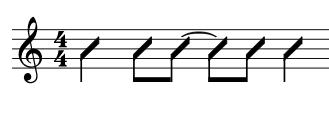Strumming patterns
July 18, 2021This post is specific to my fellow guitar players.
Strumming is something that can be a little tricky for guitar players. I recently taught a ukulele class and taught them a strumming pattern that I think often tricks people up.
Here’s the rhythm:

And the way you’d strum this pattern is below:

The main thing that tricks people up about this rhythm is beat 3. You’er playing two up strums after each other, which means in order to strum it correctly, you have to strum down without actually hitting the strings. One of my students calls this a “ghost strum.” I like that name and have been using with other students ever since. You’re “strumming” but not hitting the strings, which mostly only feels weird, at first, for down strums.
Goals of strumming
The goal of strumming is to keep your hand moving at one speed the whole time. Your hand never stops moving while you’re strumming. It’s mostly a constant “down – up – down – up” pattern that continues for the entire strumming pattern.
And if you’re playing only down strums like below:

In this strumming pattern you’re basically doing a “ghost strum” in between all of these notes. If you strum this pattern you’ll automatically “strum” up or do the motion for strumming up without hitting the strings.
The main reason we want to keep our hand moving while strumming is to keep a constant and even rhythm. Constant and even motions are more likely to create an even and constant tempo than uneven and intermittent movements. This is the primary reason that people do this.
Another reason people strum this way is because it’s idiomatic to the instrument. When you’re hearing someone strumming the guitar, you’ll likely hear someone strumming the down beats, or strong beats, as down strums and the weaker beats, or up beats, as up strums. You might sometimes here stuff broken up different where the 16th notes are up strums and the numbered beats (1, 2, 3, and 4) and the up beats (the ‘and’s) are down strums. But it’s the same idea. The weakest subdivision of the beat is the up strum.
The first pattern always tricks people up because you’re doing the same thing for an up strum.
How to practice this
My first recommendation, whenever you come across a strumming pattern that’s similar to this that tricks you up is to first take it slowly. Practice incredibly slowly. Practice so slowly that each of the strums, both up and down, can be consciously focused on. Focus on each specific up and down strum and make sure that you are constantly doing an eighth note “down – up” pattern. Almost all 8th note strumming should feel relatively like this:

This pattern is how most strumming should feel. What this does is keep the momentum going. It keeps your hand moving at a constant pace, which helps you keep the tempo. If you’re doing uneven movements it’s harder to keep the rhythm even. Especially as a beginner, without much rhythmic practice, it’s important to keep this motion even and ongoing.
So whatever rhythm you’re strumming, if it’s eighth notes, try to make it feel like the above rhythm.
Remove the ties at first
Another thing you can do to make this rhythm easier to play, when you practice at least, is to remove the ties.
Play this:

This way you’re literally playing that down strum that’ll become a “ghost strum.” Eventually you’ll want to remove this down strum, but this rhythm will get you acquianted with how that specific strum feels. So when you remove it you’ll be able to add in that “ghost strum” more easily because you’ll know how it feels.
And this technique can be used for any rhythm that has a similar tie. Practice it, at least at first, without the ties to get used to a simpler rhythm that is quite similar, and then add the ties back to be able to play the actual rhythm that you’d want to be able to play.
Practice combinations
After you’ve gotten comfortable strumming a few different strumming patterns start making them up yourself and practicing them. Add ties into different beats and see how easy that is to strum. Use only 8th notes and 8th note rests. Create different strumming patterns by yourself and practice as many different combinations as you can to get comfortable playing whatever strumming patterns you’ll see in music.
The more combinations of strumming patterns you practice, the more comfortable you’ll be playing different strumming patterns you come across in music.
ISJ